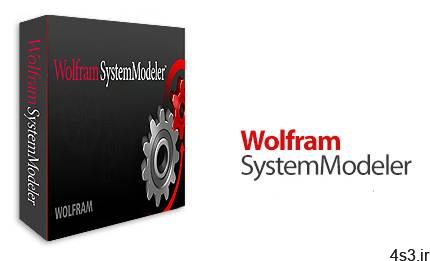

دانلود Wolfram SystemModeler v12.2.0 x64 – نرم افزار مدل سازی و شبیه سازی محیط برای سیستم های سایبر فیزیکی

سیستم سایبر فیزیکی (CPS) یک سیستم همکاری متشکل از المان های محاسباتی
برای کنترل موجودیت های فیزیکی است. امروزه، نسل پیشرو سیستم های سایبر
فیزیکی را می توان در حوزه های متنوعی مانند هوافضا، خودرو، فرایندهای
شیمیایی، زیرساخت های مدنی، انرژی، بهداشت و درمان، ساخت، حمل و نقل،
سرگرمی و لوازم مصرفی یافت. Wolfram SystemModeler نرم افزار ی
قدرتمند در زمینه مدل سازی و شبیه سازی محیط برای سیستم های سایبر فیزیکی
است. در این برنامه می توانید تنها با drag و drop کردن مدل های ساخته شده و
قابل ارتقا را از کتاب خانه مدل ها وارد محیط برنامه نمایید، مدل های صنعتی
تولید کنید و مدل های چند دامنه از یک سیستم کامل را مدل سازی کنید.
قابلیت محاسباتی تعبیه شده در این نرم افزار نیز محیطی جامع را برای فهم،
تجزیه و تحلیل و تسریع روند طراحی سیستم در اختیار کاربران قرار می دهد.
با استفاده از کامپوننت ها و ابزار تعبیه شده در این نرم افزار شما قادرید
تا سیستم خود را به صورت کلی و یا جزئی طراحی نمایید، مدل ها را آزمایش
نموده، نتایج را با استفاده از ریاضیات و محاسبات عددی بدست آورید و رفتار و
عملکرد آن ها را تجزیه و تحلیل کرده و بهبود ببخشید. قابلیت های کلیدی نرم افزار Wolfram SystemModeler: – دارای کتاب خانه ای شامل مدل های از پیش ساخته شده – امکان مدل سازی سیستم های هیبریدی – شامل کتابخانه ای از کامپوننت ها با قابلیت شخصی سازی – امکان ایجاد و اشتراک خروجی – کنترل شبیه سازی برنامه – کالیبراسیون مدل – انجام محاسبات عددی و تحلیل های ریاضی – و …
ارسال لینک این صفحه از طریق ایمیل
اشتراک گذاری لینک این صفحه در WhatsApp
اشتراک گذاری لینک این صفحه در تلگرام
Tweet نمودن این مطلب!
اشتراک گذاری این مطلب در Facebook
اضافه نمودن این مطلب به بوک مارک گوگل
کپی نشانی کوتاه این صفحه در حافظه
Wolfram SystemModeler is an easy-to-use, next-generation modeling and simulation environment for cyber-physical systems. Using drag-and-drop from the large selection of built-in and expandable modeling libraries, you can build industrial strength, multidomain models of your complete system. Adding the power of Mathematica gives you a fully integrated environment for analyzing, understanding, and quickly iterating system designs. Driving insight, innovation, and results.
Drag & Drop Modeling Quickly and intuitively create models using SystemModeler’s drag-and-drop approach. Pick up components like transistors or springs, and drop them onto the canvas. Draw lines between components to indicate physical connections like electrical wiring or mechanical attachment. Click components to specify units and unit prefixes. Library Store Expand the capabilities of SystemModeler by adding paid and free libraries from a wide and expanding range of different areas available in the SystemModeler Library Store. Libraries contain reusable components with viewable source code, documentation, and detailed examples. Multidomain Modeling Real-world machines and systems are rarely confined to a single physical domain such as mechanical, electrical, or thermal. SystemModeler models can contain any combination of interconnected components from any number of domains. Under simulation, these more realistic multidomain models can uncover important effects that would be missed using a less integrated approach. Hierarchical Modeling Create hierarchical component-based models that follow the topology of the real-world system and that are easier to develop and understand than traditional “block-based” models. In SystemModeler, individual submodels are separately testable and reusable, allowing you to quickly explore alternative designs and scenarios. Hybrid Systems Modeling Accurately model hybrid discrete-continuous systems by combining discrete signals and the built-in StateGraph library with continuous physical components. SystemModeler’s numerical solvers detect and handle discontinuities in hybrid systems, so models with sudden events such as switches, collisions, or state transitions are correctly simulated. Modelica Standard Libraries SystemModeler comes with a large library of standard Modelica packages built in, including components modeling translational, rotational, and three-dimensional mechanics, electronics, logical and signal blocks, biochemical pathways, and more. Libraries include full source code and documentation. Simulation & Experimentation Automatically translate models into optimized systems of differential equations suitable for immediate simulation. A point-and-click interface for adjusting model parameters allows rapid exploration without recompiling the model. Pause and resume simulations in progress, and synchronize simulations to run in real time. Custom Components and Libraries Construct reusable custom components, either with existing components or directly from their defining equations. Specify component icons and styles for new types of connection lines, and group sets of related libraries in redistributable Modelica packages. Third-party Modelica libraries are available for many specialized domains. Instant Visualization Plot the value of a system variable with a single click. Plot multiple variables, create parametric plots, and choose from built-in plot styles with a point-and-click interface. Attach visualization geometries from CAD software to components, and automatically create live 3D animations for models with 3D mechanical components. Connect to Mathematica for programmable custom visualization. Export & Publish Results Numerical simulation results can be directly exported in CSV or MAT format. Plots can be exported in standard image formats (PNG, JPG, etc.) and plot data can be exported in CSV format. Automatically publish models and accompanying simulation results in interactively browsable web pages. Standalone Simulation Executable The optimized simulation executable compiled by SystemModeler is self-contained, including all numerical solvers, and is suitable for reuse, such as in a custom desktop application. The compiled executable reads parameter values and initial conditions from an XML file that you can easily generate programmatically, and simulation results are returned in a standard format that you can interpret in your application. Connectivity Export models as an FMU, via the Functional Mock-up Interface (FMI) standard for model exchange. Models can also be imported from other tools that are following the FMI standard.
More info (open/close)
شرکت سازنده:
Wolfram
نام انگلیسی:
Wolfram SystemModeler
شماره نسخه:
v12.2.0
حجم فایل:
241 مگابایت
تاریخ انتشار:
14:30 – 1399/9/20 | 2020.12.10
منبع: پی سی دانلود / www.p30download.ir
امتیاز: 2.5/5
سیستم مورد نیاز
Hardware Specifications:Processor: x86-64 compatible CPUDisk Space: 2 GBSystem Memory (RAM): 4 GBMicrosoft Windows (64-bit):Windows 10 – System Modeler requires Microsoft Visual Studio to be installed. Visual C++ Build Tools can be installed for free.
1- نرم افزار را نصب کنید.2- فایل Keygen.exe موجود در پوشه Keygen را اجرا کنید (در محیط کامندلاین باز می شود.) و برای پسورد درخواست شده مقدار xsava.xyz را وارد کنید و اینتر را بزنید.3- نرم افزار را اجرا کنید.4- بر روی Other ways to activate و سپس Manual Activation کلیک کنید.5- عبارت مقابل MathID را در پنجره کامندلاین Keygen وارد کنید و اینتر را بزنید.6- مقادیر ایجاد شده برای Activation Key و Password را در پنجره برنامه وارد کنید و سپس دکمه Activate را بزنید و مراحل را تا انتها ادامه دهید.7- نرم افزار را یکبار بسته و مجددا اجرا کنید و از تمام قابلیت های آن بدون محدودیت استفاده کنید.
منبع : پی سی دانلود
رمز فایل : www.p30download.com
241 مگابایت دانلود با حجم :

13 کیلوبایت دانلود با حجم :

227 مگابایت دانلود با حجم :















































































